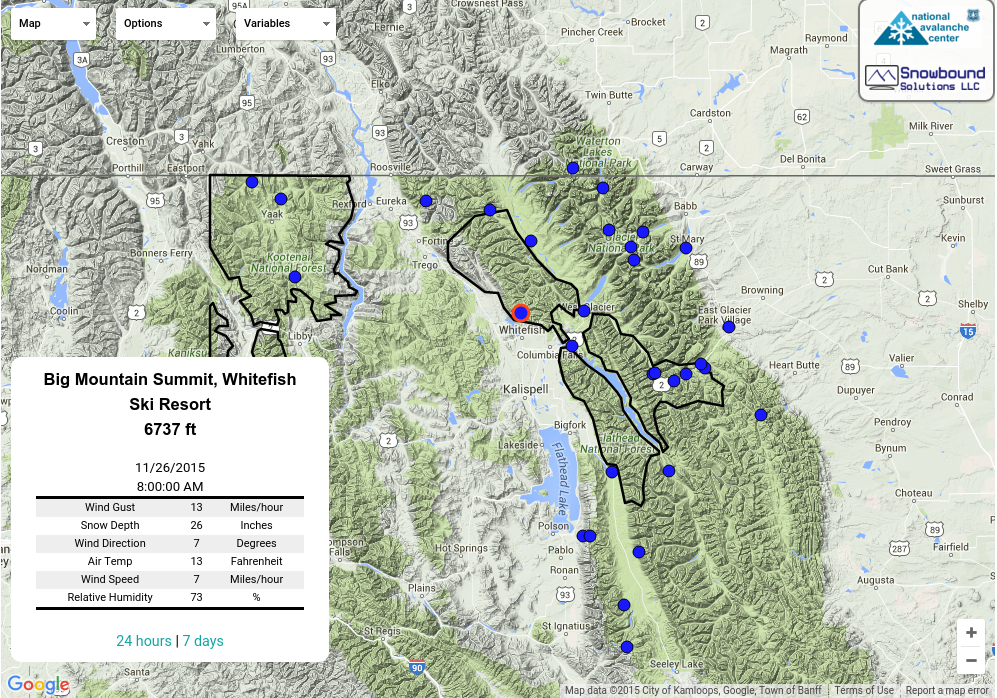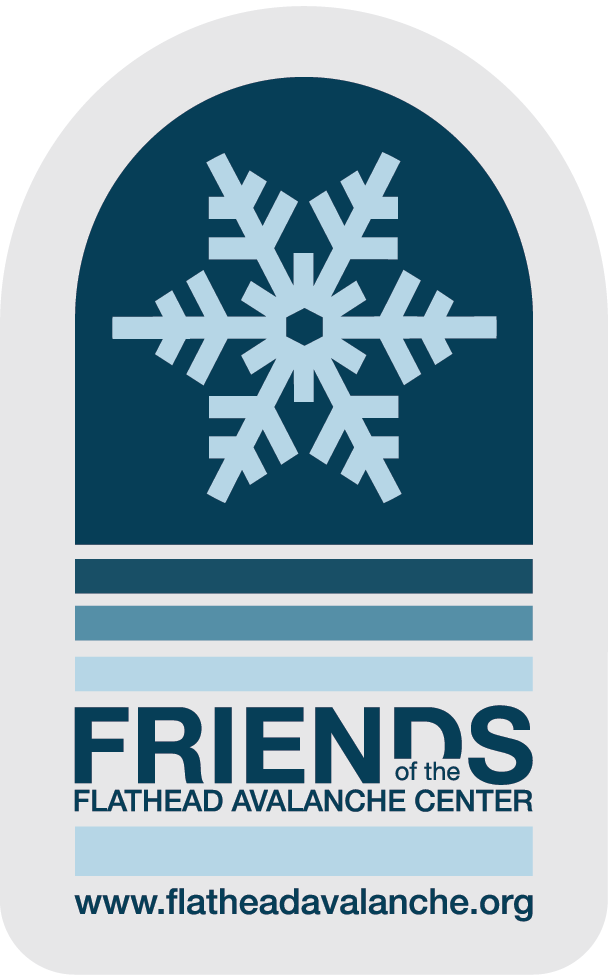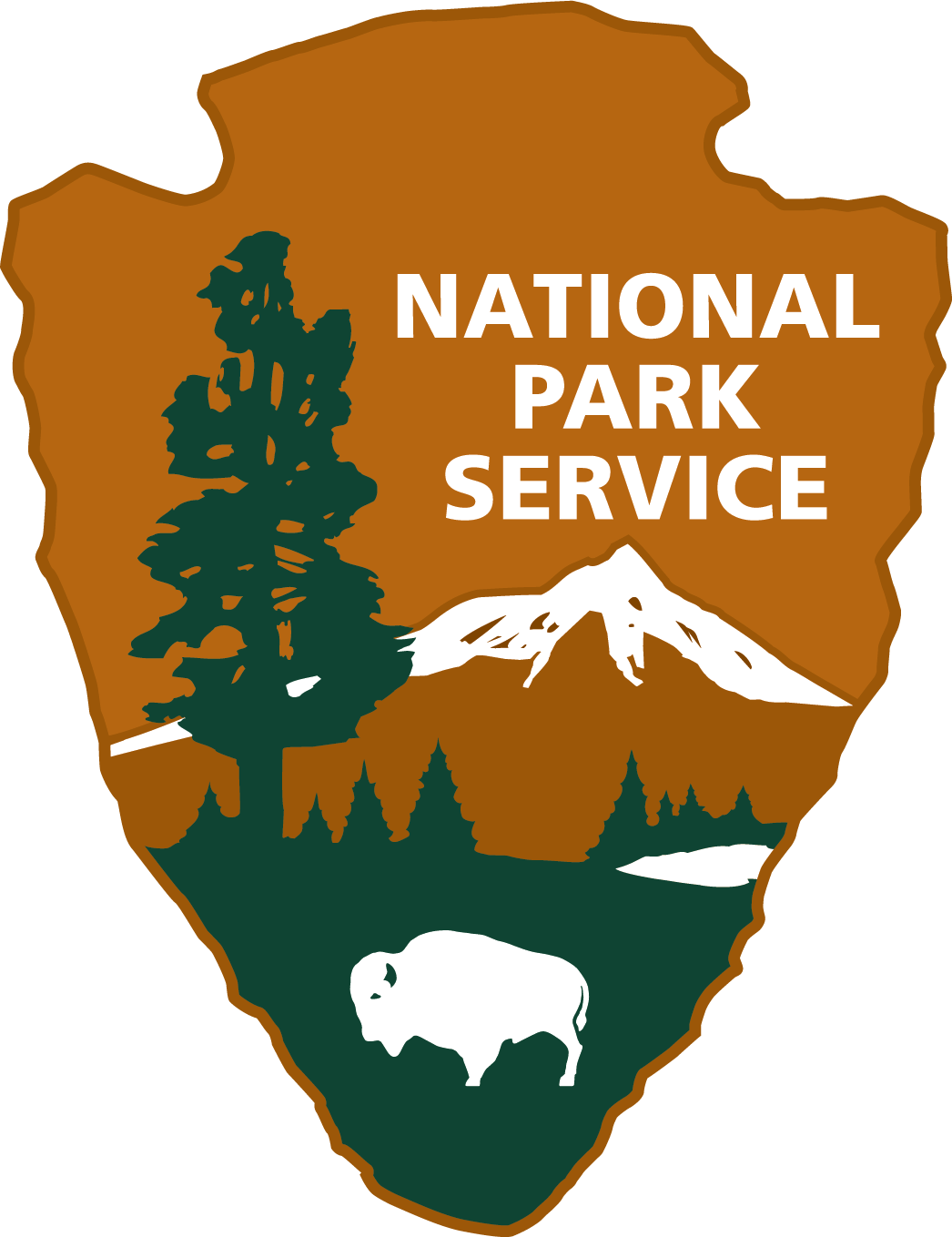Use this page to view archived advisories. The table below shows the overall danger rating and the bottom line for the 20 most recent advisories. Click on the time and date link above each danger rating icon to view the full advisory for that day. Use the date chooser or the pager at the bottom to scroll through the older advisories.
|
Date the advisory was published: |
Forecast Region | |
|---|---|---|
|
Click here to see the full advisory for 2021-01-18 |
January 18, 2021 at 6:55 In areas without a stout near-surface crust, you can impact a buried weak layer 1-3' below the surface, resulting in a larger slide. That hazard is relatively widespread at upper-elevations and isolated at mid-elevations. When in doubt, default to planar slopes less than 35 degrees with runouts free of surface obstacles and terrain traps. |
Whitefish Range |
|
Click here to see the full advisory for 2021-01-18 |
January 18, 2021 at 6:55 In areas without a stout near-surface crust, you can impact a buried weak layer 1-3' below the surface, resulting in a larger slide. That hazard is relatively widespread at upper-elevations and isolated at mid-elevations. When in doubt, default to planar slopes less than 35 degrees with runouts free of surface obstacles and terrain traps. |
Flathead Range and Glacier National Park |
|
Click here to see the full advisory for 2021-01-18 |
January 18, 2021 at 6:07 Triggering a slide in yesterday's storm snow remains our main concern. Avalanches have the potential to run long distances on top of a crust. In areas without a stout near-surface crust, you can impact a buried weak layer 1-3' below the surface, resulting in a larger slide. On steep slopes, steer around areas harboring dense snow that doesn't bond to the underlying crust. When in doubt, default to lower angle terrain free of rollovers. |
Swan Range |
|
Click here to see the full advisory for 2021-01-17 |
January 17, 2021 at 9:30 Due to an overproducing storm, we are reissuing the Whitefish forecast. You can still trigger a weak layer buried 1-3 feet below the surface in areas not capped by a thick crust. In these areas, choose lower-angled, planar terrain. Anticipate thin slabs forming throughout the day. These will be thicker and more widespread as you gain elevation, especially on leeward slopes. Finish your weekend off in style by steering around slopes harboring dense snow that cracks around you. |
Whitefish Range |
|
Click here to see the full advisory for 2021-01-17 |
January 17, 2021 at 6:58 Today's fresh snow is a beautiful sight, but don't forget about what is hidden under the surface. You can still trigger a weak layer buried 1-3 feet below the surface in areas not capped by a thick crust. Anticipate sluffing in the new snow, especially as you gain elevation. Finish your weekend off in style by choosing lower angle planar terrain in areas without a surface crust. Opt for slopes with good runouts free of terrain traps and surface obstacles. |
Flathead Range and Glacier National Park |
|
Click here to see the full advisory for 2021-01-17 |
January 17, 2021 at 6:50 Due to an overproducing storm, we have reissued the Swan forecast. Anticipate thin slabs forming throughout the day. These will be thicker and more widespread as you gain elevation, especially on leeward slopes. You can still trigger a weak layer buried 1-3 feet below the surface in areas not capped by a thick crust. In these areas, choose lower-angled, planar terrain. Finish your weekend off in style by steering around slopes harboring dense snow that cracks around you. |
Swan Range |
|
Click here to see the full advisory for 2021-01-16 |
January 16, 2021 at 5:34 On steep slopes where the snow surface isn't a thick, hard crust, you can still trigger slides that break 1 to 3 feet deep on weak layers buried by this week's storm. Reduce your risk of triggering a slide by sticking to slopes less than 35 degrees that have runouts free of obstacles. The hard, slick rain crust makes for difficult travel and slide-for-life conditions on other steep slopes. |
Whitefish Range |
|
Click here to see the full advisory for 2021-01-16 |
January 16, 2021 at 5:34 On steep slopes where the snow surface isn't a thick, hard crust, you can still trigger slides that break 1 to 3 feet deep on weak layers buried by this week's storm. Reduce your risk of triggering a slide by sticking to slopes less than 35 degrees that have runouts free of obstacles. The hard, slick rain crust makes for difficult travel and slide-for-life conditions on other steep slopes. |
Swan Range |
|
Click here to see the full advisory for 2021-01-16 |
January 16, 2021 at 5:34 On steep slopes where the snow surface isn't a thick, hard crust, you can still trigger slides that break 1 to 3 feet deep on weak layers buried by this week's storm. Reduce your risk of triggering a slide by sticking to slopes less than 35 degrees that have runouts free of obstacles. The hard, slick rain crust makes for difficult travel and slide-for-life conditions on other steep slopes. |
Flathead Range and Glacier National Park |
|
Click here to see the full advisory for 2021-01-15 |
January 15, 2021 at 5:36 You can still trigger slides that break 1 to 4 feet deep on steep slopes where a thick, hard crust doesn't exist at the surface. That hazard is relatively widespread at upper elevations, and isolated at mid elevations. You can reduce your risk of triggering a slide by sticking to slopes less than 35 degrees that have runouts free of trees, rocks, and gullies. The hard, slick rain crust makes for difficult travel and slide-for-life conditions on other steep slopes. |
Whitefish Range |
|
Click here to see the full advisory for 2021-01-15 |
January 15, 2021 at 5:36 You can still trigger slides that break 1 to 4 feet deep on steep slopes where a thick, hard crust doesn't exist at the surface. That hazard is relatively widespread at upper elevations, and isolated at mid elevations. You can reduce your risk of triggering a slide by sticking to slopes less than 35 degrees that have runouts free of trees, rocks, and gullies. The hard, slick rain crust makes for difficult travel and slide-for-life conditions on other steep slopes. |
Swan Range |
|
Click here to see the full advisory for 2021-01-15 |
January 15, 2021 at 5:36 You can still trigger slides that break 1 to 4 feet deep on steep slopes where a thick, hard crust doesn't exist at the surface. That hazard is relatively widespread at upper elevations, and isolated at mid elevations. You can reduce your risk of triggering a slide by sticking to slopes less than 35 degrees that have runouts free of trees, rocks, and gullies. The hard, slick rain crust makes for difficult travel and slide-for-life conditions on other steep slopes. |
Flathead Range and Glacier National Park |
|
Click here to see the full advisory for 2021-01-14 |
January 14, 2021 at 6:23 Large and dangerous slabs are likely still unstable below the highest peaks and ridgelines today. Use terrain to limit your exposure to the overhead hazards from freshly-loaded starting zones and large avalanche paths. Below the most recent rain/snow line, a thick crust has locked up the snowpack and created slide-for-life conditions. |
Whitefish Range |
|
Click here to see the full advisory for 2021-01-14 |
January 14, 2021 at 6:23 Large and dangerous slabs are likely still unstable below the highest peaks and ridgelines today. Use terrain to limit your exposure to the overhead hazards from freshly-loaded starting zones and large avalanche paths. Below the most recent rain/snow line, a thick crust has locked up the snowpack and created slide-for-life conditions. |
Swan Range |
|
Click here to see the full advisory for 2021-01-14 |
January 14, 2021 at 6:23 Large and dangerous slabs are likely still unstable below the highest peaks and ridgelines today. Use terrain to limit your exposure to the overhead hazards from freshly-loaded starting zones and large avalanche paths. Below the most recent rain/snow line, a thick crust has locked up the snowpack and created slide-for-life conditions. |
Flathead Range and Glacier National Park |
|
Click here to see the full advisory for 2021-01-13 |
January 13, 2021 at 6:44 An Avalanche Warning is in effect until midnight tonight. Very dangerous avalanche conditions have developed overnight and large natural avalanches are expected today. You may be able to trigger very large avalanches from a distance. Loading from intense snowfall will last throughout the morning and strong winds will continue to build drifts through tonight. Avoid traveling on and under slopes steeper than about 30 degrees. Very large avalanches can come from above and run into the lower elevations. |
Swan Range |
|
Click here to see the full advisory for 2021-01-13 |
January 13, 2021 at 6:44 An Avalanche Warning is in effect until midnight tonight. Very dangerous avalanche conditions have developed overnight and large natural avalanches are expected today. You may be able to trigger very large avalanches from a distance. Loading from intense snowfall will last throughout the morning and strong winds will continue to build drifts through tonight. Avoid traveling on and under slopes steeper than about 30 degrees. Very large avalanches can come from above and run into the lower elevations. |
Flathead Range and Glacier National Park |
|
Click here to see the full advisory for 2021-01-13 |
January 13, 2021 at 6:44 An Avalanche Warning is in effect until midnight tonight. Very dangerous avalanche conditions have developed overnight and large natural avalanches are expected today. You may be able to trigger very large avalanches from a distance. Loading from intense snowfall will last throughout the morning and strong winds will continue to build drifts through tonight. Avoid traveling on and under slopes steeper than about 30 degrees. Very large avalanches can come from above and run into the lower elevations. |
Whitefish Range |
|
Click here to see the full advisory for 2021-01-12 |
January 12, 2021 at 7:07 An Avalanche Watch has been issued. Expect increasing danger during the next 48 hours. Rain on snow, and new snow falling on a variety of weak surfaces can cause avalanches large enough to bury and injure you. There is an increased likelihood of triggering a larger, persistent slab avalanche. If you see 8 or more inches of new snow pile up, or rain on snow, stick to slopes less than roughly 35 degrees and stay out from underneath larger paths. |
Whitefish Range |
|
Click here to see the full advisory for 2021-01-12 |
January 12, 2021 at 7:07 An Avalanche Watch has been issued. Expect increasing danger during the next 48 hours. Rain on snow, and new snow falling on a variety of weak surfaces can cause avalanches large enough to bury and injure you. There is an increased likelihood of triggering a larger, persistent slab avalanche. If you see 8 or more inches of new snow pile up, or rain on snow, stick to slopes less than roughly 35 degrees and stay out from underneath larger paths. |
Swan Range |
|
Click here to see the full advisory for 2021-01-12 |
January 12, 2021 at 6:52 An Avalanche Watch has been issued. Expect increasing danger during the next 48 hours. Rain on snow, and new snow falling on a variety of weak surfaces can cause avalanches large enough to bury and injure you. There is an increased likelihood of triggering a larger, persistent slab avalanche. If you see 8 or more inches of new snow pile up, or rain on snow, stick to slopes less than roughly 35 degrees and stay out from underneath larger paths. |
Flathead Range and Glacier National Park |
|
Click here to see the full advisory for 2021-01-11 |
January 11, 2021 at 6:52 Slabs failing on persistent weak layers buried 1-4’ deep remains our primary concern. You are more likely to get into trouble where a reactive layer of buried surface hoar exists. This layer is spotty in the Whitefish Range and requires digging to assess if it is on the slopes you plan to ride. If you choose to venture into steep terrain, choose well supported, planner, or concave slopes. Avoid steep rollovers and rocky, complex start zones. |
Whitefish Range |
|
Click here to see the full advisory for 2021-01-11 |
January 11, 2021 at 6:37 Slabs failing on persistent weak layers buried 1-4’ deep remains our primary concern. You are more likely to get into trouble where a more reactive layer of buried surface hoar exists. Choose well supported, planner, or concave slopes and avoid steep rollovers and rocky, thin alpine start zones. Avoid dawdling beneath cornices as recent failures have pulled out wind slab avalanches below. |
Flathead Range and Glacier National Park |
|
Click here to see the full advisory for 2021-01-11 |
January 11, 2021 at 6:37 Slabs failing on persistent weak layers buried 1-4’ deep remains our primary concern. You are more likely to get into trouble where a more reactive layer of buried surface hoar exists. Choose well supported, planner, or concave slopes and avoid steep rollovers and rocky, thin alpine start zones. Avoid dawdling beneath cornices as recent failures have pulled out wind slab avalanches below. |
Swan Range |
|
Click here to see the full advisory for 2021-01-10 |
January 10, 2021 at 6:50 You can get into trouble if you impact a weak layer buried 1-4’ beneath the surface, especially in the Flathead Range, where observers report a reactive surface hoar layer. Wind slabs formed earlier in the week continue to strengthen, but deserve your attention. Choose terrain to minimize your risk from the high consequence of a Persistent Slab. Planar slopes with a deep uniform snowpack are a wiser choice than rollovers and thin snow cover areas. |
Flathead Range and Glacier National Park |
|
Click here to see the full advisory for 2021-01-10 |
January 10, 2021 at 6:50 You can get into trouble if you impact a weak layer buried 1-4’ beneath the surface, especially in the Flathead Range, where observers report a reactive surface hoar layer. Wind slabs formed earlier in the week continue to strengthen, but deserve your attention. Choose terrain to minimize your risk from the high consequence of a Persistent Slab. Planar slopes with a deep uniform snowpack are a wiser choice than rollovers and thin snow cover areas. |
Swan Range |
|
Click here to see the full advisory for 2021-01-10 |
January 10, 2021 at 6:39 Wind slabs formed earlier in the week continue to strengthen, but deserve your attention. You can get into trouble if you impact a buried weak layer 1-4’ beneath the surface. Look and feel for stiff, dense snow with cracking the sign of a reactive slab. Choose terrain to minimize your risk from the high consequence of a Persistent Slab. Planar slopes with a deep uniform snowpack are a wiser choice than rollovers and thin snow cover areas. |
Whitefish Range |
|
Click here to see the full advisory for 2021-01-09 |
January 9, 2021 at 7:07 Several generations of wind slabs found on wind-loaded slopes are healing slowly, but you should still approach them with caution. Cracking is a sign that you have found an unstable slab. Triggering a slide on a weak layer buried 1-4’ deep remains a concern. After reports of reactive buried surface hoar Friday, we've increased the likelihood that you could trigger a large dangerous avalanche. If you are not interested in digging, choosing planar well-supported terrain is your safest choice. |
Whitefish Range |
|
Click here to see the full advisory for 2021-01-09 |
January 9, 2021 at 6:12 Triggering slides on a weak layer buried 1-4’ deep is today’s number one concern. After reports of reactive buried surface hoar Friday, we've increased the likelihood that you could trigger a large, dangerous avalanche. Several generations of wind slabs found on wind-loaded slopes are healing slowly, but you should still approach them with caution. If you are not interested in digging, choosing planar well-supported terrain is your safest choice. Cracking is a sign that you have found a reactive slab. |
Flathead Range and Glacier National Park |
|
Click here to see the full advisory for 2021-01-09 |
January 9, 2021 at 6:12 Triggering slides on a weak layer buried 1-4’ deep is today’s number one concern. After reports of reactive buried surface hoar Friday, we've increased the likelihood that you could trigger a large, dangerous avalanche. Several generations of wind slabs found on wind-loaded slopes are healing slowly, but you should still approach them with caution. If you are not interested in digging, choosing planar well-supported terrain is your safest choice. Cracking is a sign that you have found a reactive slab. |
Swan Range |










